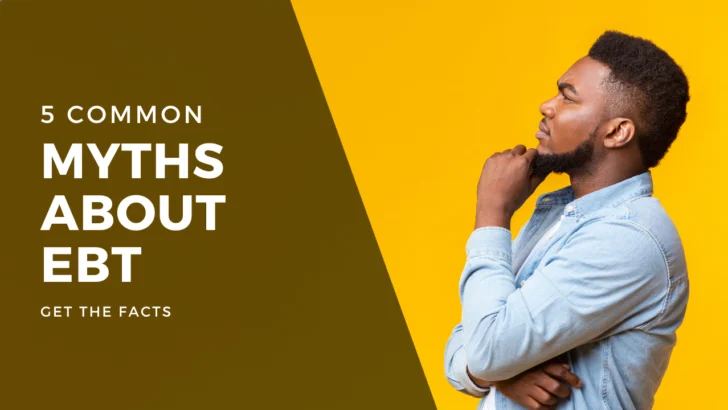Stop believing these common myths about food stamps! These are constantly being repeated and parroted by people who want to convince you that this program is rampant with abuse and not really helping anyone. However, we’ve done the research and we have the facts.
Myth #1: Only “certain people” get food stamps.
Many of the myths about social programs – and the Supplemental Nutrition Assistance Program in particular – have to do with who is getting the benefits.
Many people believe that only certain groups of people get food stamps. Depending on who you ask, this group could be defined by racial, gender, or other identifying traits.
However, let’s review a few important facts from the Food & Nutrition Service:
- About 12% of the total US population received Supplemental Nutrition Assistance Benefits in 2019.
- Only 4% of all SNAP households receive cash benefits.
- When you look at it by individuals who are getting these benefits, 43% are children, 16% are age 60 or older and 10% are non-elderly adults with disabilities.
- When you look at it by household, 86% of all SNAP benefits go to households that contain at least one child, elderly person or disabled adult.
- By sheer number, white people are more likely to get food stamps than any other race-based demographic.
Myth #2: Welfare makes people lazy.
One of the most prevailing and persistent myths about food stamps is that it makes people lazy. However, this is simply not true. The vast majority of these benefits go to children, disabled people and elderly adults who can’t simply “hustle harder” to make ends meet.
Let’s review the facts.
- The average length of time that people receive SNAP is 8-10 months.
- About ⅔ of SNAP households receive less than the maximum benefits.
- 1 in 10 users get only $15 per month.
- Almost ⅓ of SNAP households have earned income, which means they are working.
- Almost ⅓ of SNAP households receive Social Security benefits due to disability or retirement.
- Households with children are even more likely to work, with 54% of them earning income.
Let’s be honest: $15 is not enough to buy groceries for a week, let alone support a household for an entire month. Nobody is quitting their jobs and living off $15 per month in food stamps, guys. These programs exist to bridge the gap between what people earn and what they need.
Myth #3: Food Stamps hurts the economy.
Some people believe that food stamps hurts the economy but the data does not support this. It is clearly one of the most obvious myths about food stamps.
According to Moody’s Analytics, every $1 in SNAP benefits generates $1.67 in economic activity. That’s more effective than federal aid to state governments or cutting corporate tax rates.
In 2013, the Washington Post reported that the entire economy of Woonsocket, Rhode Island, exists on a boom-and-bust cycle. When benefits are disbursed on the first, all the stores are stocked and ready for tons of shoppers… and then throughout the month, as benefits dwindle, there are fewer and fewer shoppers. Some retailers reported that they made 25% or more of their monthly sales when SNAP funds were distributed.
This food program helps families eat, but it also helps the businesses that sell the food to the families, and the farms that produce the food, and so on.
Myth #4: Food Stamps costs taxpayers too much money.
Not a single day goes by that someone isn’t in our comments section blaming me for single handedly stealing all their tax money… but the reality is that very little is actually spent on these social nets. When you look at the federal budget, it’s obvious this is one of the worst myths about food stamps.
According to the Center on Budget and Policy Priorities, the government spent $4.4 trillion in fiscal year 2019. Here’s where some of that money went:
- 25% of it went to health care costs, through Medicare, Medicaid, CHIP and marketplace subsidies.
- 23% of it went to Social Security
- 16% went to defense spending.
- 8% went to safety net programs including tax credits, SSI, TANF, SNAP, school meals, low income housing assistance, child care assistance, LIHEAP and other programs.
8%. That’s all. That’s eight cents out of every dollar for ALL of the non-health-care-related social safety net programs put together. When you isolate just the amount spent on food stamps, it’s 1.4% of the federal budget. That’s about a penny and a half out of every dollar.
And it’s a penny and a half I’ll gladly pay to keep feeding children, seniors, disabled people and others who are down on their luck. Compared to the rest of the budget, it’s just not that much.
Myth #5: You’ll never need food stamps.
Perhaps the worst of the myths about food stamps is that you’ll never use it. Most Americans are one missed paycheck away from poverty, but nobody is one paycheck away from becoming a billionaire. An unexpected illness, disability, layoff, termination, or accident could easily push most Americans into these safety nets.
Someday, you may very well need this program and when you do, you’ll be glad it’s there to help.

